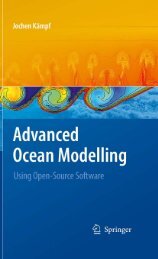Contents
Contents
Contents
- No tags were found...
Create successful ePaper yourself
Turn your PDF publications into a flip-book with our unique Google optimized e-Paper software.
PrefaceThis book focuses on the dynamics of the ocean being influence by the Earth’s rotationand density stratification Fluids in motion are a difficul subject of study thattraditionally requires advanced knowledge of analytical mathematics, in particularlymatrix algebra, differential and integral calculus, and complex analysis. Hence, thisfascinating fiel of science, known as geophysical flui dynamics, is accessible onlyto a limited number of students – those who either are naturally geniuses or thosewho underwent tough years of intense University study.Fluid processes are inherently complex and analytical solutions describing fluidynamics exist only in a few instances and only under highly simplifie assumptions.Computer-based numerical models are required to approximate flui behaviorin more realistic situations. Because of its complexity, universities tend to offersubjects in computational modelling of flui dynamics only at postgraduate level.This is a pity given that flui processes are truly fascinating in nature and given thatthe oceans play a significan role in shaping life on Earth.The approach I pursue in this book is different from the traditional approach.Here, numerical models are gradually built up and refine with the objective toillustrate and explore various dynamical processes occurring in fluids Little mathematicalbackground knowledge is required, and the focus is placed where it shouldbe, namely on the physics inherent with fluid in motion. This book is a combinationof a textbook and a workbook including more than 20 computer-based exercises,written in FORTRAN 95. Analytical solutions of certain flui phenomena are usedas invaluable benchmarks for verificatio of these model simulations. In parallel tothis book, the reader is encouraged to consult textbooks by Cushman-Roisin (1994),Pond and Pickard (1983) and Gill (1982).The modelling-based approach has many advantages over the traditional analyticalapproach and, in the author’s belief, will open the fiel of geophysical fluidynamics to a much broader audience. Obvious advantages are that (a) complexflui processes such as barotropic or baroclinic instabilities, otherwise exclusivelyreserved to experts, can be studied by a lay person, (b) instead of still pictures ofresults, the reader can create animations of processes, and (c) the reader can adoptcomputer codes, provided in this book, in a modifie form for own independentstudies. Without doubt, learning is greatly enhanced by playing and this book providesthe reader with the tools (or toys) to achieve this.v
















